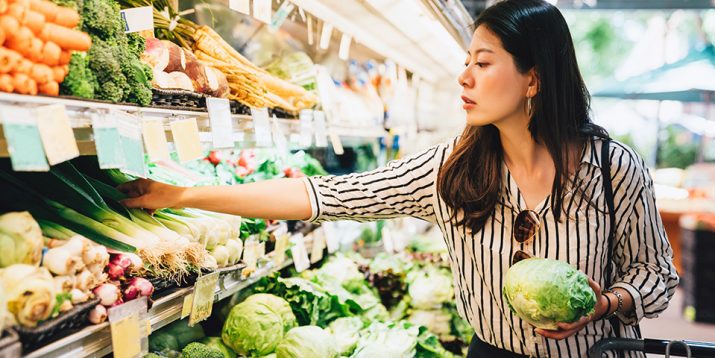Basic Grocery List for Healthy Meal Planning

You’ve made the decision to eat more healthfully — now what? How do you know what basic groceries you’ll need to prep healthy meals and stick to your nutrition goals?
Grocery shopping can be overwhelming as it is — according to the Food Marketing Institute, the average supermarket has around 30,000 items to choose from.
So we asked nutrition experts to explain the best methods for coming up with a basic grocery list of healthy staples you should always have on hand in your kitchen.
How to Create a Basic Grocery List
“It’s always best to go to the grocery store with a basic grocery list in hand — this can help prevent impulse buys and keep you on budget,” says Krista Maguire, R.D., C.S.S.D. and senior nutrition manager at BODi.
The good news?
Once you take the time to nail down a good basic grocery list, it’ll only take only a few minutes to figure out what you need on future shopping trips.
“I find the best way to go about building a healthy grocery list is to plan out your meals for the week,” adds Maguire. “When you have an idea of what you’ll be eating, you’ll know exactly what you need to buy.”
Use the basic grocery list below as your baseline, then add whatever additional ingredients you’ll need for any healthy recipes you plan to try this week.
Most recipes yield multiple servings, so if you live alone, plan on using the leftovers as meal prep.
For example, say you want to make spaghetti with spinach and ground turkey: “You’ll likely buy one box of pasta, one package of ground turkey, one jar of pasta sauce, and one bunch of spinach,” says Maleah Staton, R.D.
That’ll yield enough food to cover 4 to 6 of your meals for the week.
Creating a Basic Grocery List on a Budget
It’s expensive to eat healthy — or is it? Healthy food has a reputation for being a wallet buster, but you can eat well on a budget if you plan ahead.
“If you’re on a budget, you can opt for recipes and foods that are less expensive,” says Maguire. “For example, choosing chicken over steak should save some money, or eggs instead of fish.”
Bulk foods are usually more affordable than pre-packaged foods, so Maguire recommends buying pantry staples like grains, beans, nuts, and spices in bulk.
And don’t pay for the convenience of pre-chopped fruits, veggies, and salad mixes.
“Sticking to whole foods instead of packaged items is a great way to lighten the total grocery bill,” Maguire says.
It may take some extra time to prep your foods, but your wallet will thank you.
The Best Staple Foods to Add to Your Basic Grocery List
There are certain healthy foods you should always keep on hand, so they’re there when you need a snack or a last-minute healthy meal.
“There are so many things you can do with chicken breast, ground turkey, eggs, and organic tofu,” says Maguire.
“Also, [stock up on] a variety of canned beans — like garbanzo beans to make hummus, or black beans to throw in a breakfast taco or on top of a salad or into a mixed grain and veggie bowl, she adds.
And make sure you always have the ingredients you need to make the healthy treats you (and your taste buds) love.
“Some staples I find myself always buying include oatmeal, bananas, almond milk, nut butter, walnuts, eggs, avocado, and sprouted bread,” says Maguire.
Here are the healthy staples you need.
For the refrigerator and freezer:
- Fresh fruit (“It’s nice to have some you can grab for on-the-go snacks like bananas or apples,” says Maguire.)
- Frozen fruit
- Fresh veggies
- Frozen veggies (“My freezer staples include frozen riced cauliflower, frozen kale, and broccoli,” says Staton.)
- Protein of choice (chicken, fish, steak, organic tempeh, organic tofu, canned tuna, or salmon)
- Milk or an unsweetened non-dairy milk alternative
- Unsweetened plain Greek yogurt
- Eggs (ideally local or pasture-raised eggs)
For the pantry:
- Non-refrigerated fruits and vegetables (sweet potatoes, avocados, tomatoes)
- Dry whole grains (oats, quinoa, brown rice)
- Canned beans (garbanzo, pinto, black)
- Dry pasta
- Bread (sprouted or whole grain)
- Nut butters
- Condiments (olive oil, vinegar, mustard, salad dressing, salsa)
- Natural sweeteners (honey, maple syrup)
- Snacks (air-popped popcorn, whole-grain crackers, dried fruit, nuts)
For the spice rack:
Spices can really amp up the flavor in healthy dishes without adding calories or sugar.
“I love using basil in Asian or Italian dishes and cilantro, curry, and cumin in Mexican or Indian dishes,” says Staton.
Keep these on hand:
- Sea salt
- Pepper
- Basil
- Cilantro
- Curry
- Cumin
- Garlic powder
- Onion powder
- Chili powder
- Cinnamon
- Thyme
- Oregano
- Rosemary





